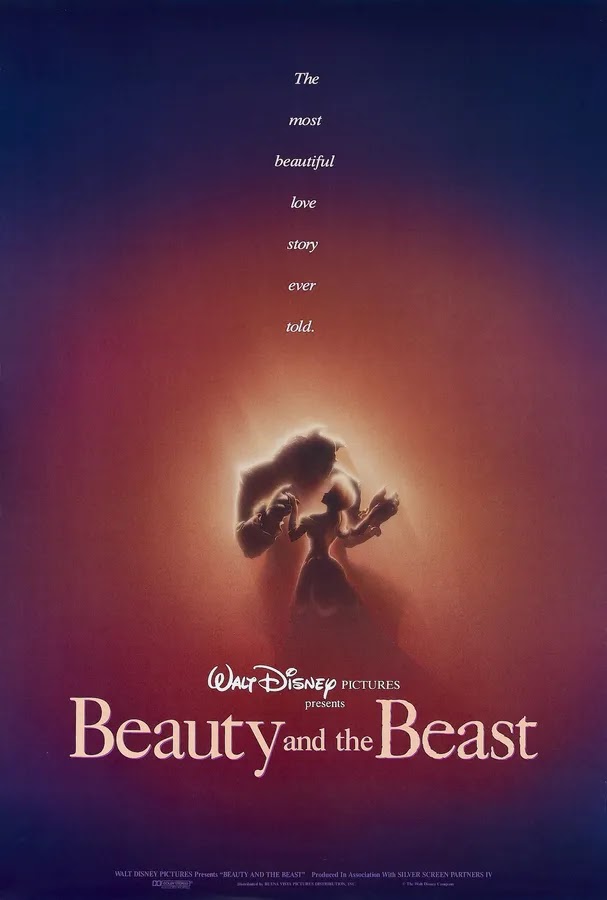Image source: https://wallpapers.com/picture/beauty-and-the-beast-pictures-71xwm97a0txnezdv/download.
Beauty and the Beast is among the first Disney films with complex/well-written characters. The Beast's desire to be loved and Belle's desire for adventure are both relatable. The Beast (Robby Benson) stays in his castle until he learns to love others despite their appearances. Belle (Paige O'Hara) gives up her dreams only to find them in the castle, freeing her from dependence on her father winning first prize.
Belle is distinct from other Disney princesses. Like Snow White, Cinderella and Aurora; she is conventionally feminine (quiet, sweet, and patient). Unlike earlier princesses, though, Belle is an active protagonist. She speaks up for herself, her father Maurice (Rex Everhart), and the Beast when facing bigotry. Belle also saves Maurice and the Beast with her love multiple times.
As for the Beast, he fears nobody will ever love him because of his transformation. Hence, he initially throws Maurice into prison. When Belle takes his place, the Beast sees her as his last hope and feels guilty every time he attacks her. Once the Beast saves Belle from the wolves, their relationship improves.
Gaston (Richard White) is also one of my favorite Disney villains. He's a handsome and muscular man on the outside. Yet, he mistreats outcasts; Gaston tries to force Belle into marrying him and attempts to send Maurice to an asylum. A lot of Disney's villains have ugly facial characteristics, which teaches kids to associate ugliness with evil. However, Gaston sends the opposite message. Besides, while the Beast changes for the better, Gaston changes for the worse.
The household object servants, though cartoonish in look, all have excellent vocal performances and serve a purpose in the story. They, especially Cogsworth (David Ogden Stiers) and Lumiere (Jerry Orbach), give off a lot of humor.
The story is another strength in the movie. It is to-the-point with no unnecessary scenes. The primary message is to look beyond appearances, but Beauty and the Beast teaches us so much more. On a deeper lever, it teaches us to speak up for outcasts and resist the sinful ways of the world as Belle does. The story also teaches the Christlike characteristic of selflessness.
As I described above, the movie celebrates femininity. Society typically sees feminine traits such as kindness and patience as weak. Yet, Belle's femininity is a strength since she uses it to help others. Plus, the Beast adopts some of Belle's feminine traits to break the curse.
As in many Disney movies, there is a lot of color contrast. Plus, the art style (especially for Belle with her blue provincial dress and smile) is adorable. The animation highlight, however, is the ballroom scene. The animators used the CAPS system from Pixar to design the ballroom and give it a sweeping view for the audience.
The eight songs are well-spaced throughout the movie. After the Beast's backstory, the opening number "Belle" begins playing. It introduces viewers to the protagonist and musical format before the five-minute mark, which is crucial for pulling them in. All the other songs serve a purpose, whether they move the story forward ("Something There") or add character development ("Gaston"). The movie also ends in a reprise of "Beauty and the Beast," making it a proper musical (which most Disney "musicals" are not).
Beauty and the Beast has received criticism for depicting Stockholm syndrome because Belle was initially in prison. However, the Beast imprisoned visitors because, as previously mentioned, he didn't think anyone could love him. He improves his treatment of Belle gradually, such as when giving her a bedroom. Besides, Belle sees the castle as an escape from her patriarchal village and chance for adventure. Hence, she was not really trapped. Another thing is that Belle does not bond with the Beast until he changed.
The movie has a lot of positive messages, but it is not a model for real life. Two misfits falling in love in an enchanted castle, with the help of enchanted objects, only work in fairy tales. This being said, Beauty and the Beast is a mere allegory illustrating the healing power of love.
Viewers have also had questions over the years such as "Why did the servants get cursed?" and "Why doesn't the village know about the curse?" However, I find it self-explanatory. If the Beast's entire castle got cursed, it would make sense for it to affect the servants. Besides, it's a fairy tale, meaning the story's world has its own logic; it's not supposed to follow real-world logic.
The film has complex characters, strong writing, enchanting animation, and memorable songs. Hence, it's no wonder Beauty and the Beast became the first animated film to get the Best Picture nomination from the Academy Awards. It may have lost to Silence of the Lambs, but the nomination remains a major milestone.
I find Beauty and the Beast to be one of Disney's few excellent films. As someone who has always felt different, I easily connect with the story and will watch my favorite Disney movie many more times.
SCORE: Excellent (10/10)
AGE RATING: 6+
STREAMING SERVICE: Disney+
Have you seen Beauty and the Beast? What do you think about it?





No comments:
Post a Comment